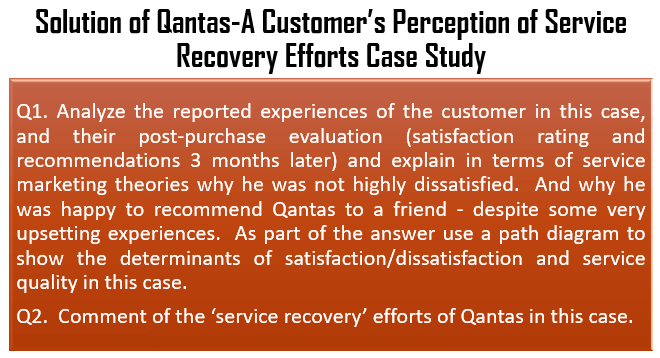Synopsis of Qantas Case
This Qantas case reports a series of dissatisfactory service encounters for a business passenger returning on a Qantas 16-hour flight from Los Angeles to Sydney. The case centers around Qantas service recovery efforts (or lack of) and the relationship between customer satisfaction/dissatisfaction (CS/D) and service quality.
Further, it demonstrates how repeat purchase intentions are linked more to prior attitudes (and perceptions of service quality) towards the brand than to service encounter CS/D. It also provides an example how lack of perceived control (control theory) and causal attributions (attribution theory) may act as moderators in the consumer evaluation process.
Two key problems Discussed in Qantas Case Study
- First, after all the issues customer faced by Qantas, they are not highly dissatisfied with their services
- Second, they still believe in Qantas services and are ready to recommend it to others.
Suggested Answers
First Question Answer;
- It should firstly be noted that the passenger in question is a highly experienced traveller and thus has realistic and well-formed expectations about what they should receive from an international airline. In CS/D evaluation, expectations form a benchmark against which performance is compared.
Further, as the passenger is a member of the Qantas Frequent Flyer program, it can be assumed they have flown Qantas many times – and therefore have a positive attitude and perceptions of Qantas’ service quality.
Service Quality (SQ)
It has in recent times been defined as having attitude like properties (Bolton & Drew 1991; Patterson and Johnson 1993). Consumers do not have to have tried a brand to have perceptions of its service quality.
One doesn’t need to visit Disneyland, flown on British Airway or be a customer of, say, ANZ Bank, to have perceptions of its quality of service. These perceptions may be formed via word-of-mouth or via some form of marketing communications.
Customer Satisfaction/Dissatisfaction
A related but different construct is transaction (service encounter/moments of truth) specific and is considered to comprise mainly affective (emotion) components.
So, why was the customer not highly dissatisfied despite some bad experiences?
Firstly, Qantas notified passengers some 2 hours out of Sydney that they would be late. This had the effect of shaping expectations (a critical variable in all satisfaction models – see Oliver 1980; Patterson 1993). Customers started to “expect” they might not arrive on time.
Second, the announcement explained it was due to bad weather – i.e. a factor outside Qantas’ control. Causal attribution theory would suggest this mediates any dissatisfaction with Qantas.
- At Melbourne airport, Qantas should have had ‘service recovery’ procedures in place to handle this type of situation. Clearly, they did not, and hence this leave passengers with a sense of having no behavioural or cognitive control over the situation – i.e., not knowing when, if, how, they would get to Sydney. This usually exacerbates dissatisfaction.
- The attempt at ‘service recovery’ by the Qantas steward (and Qantas by upgrading to 1st Class) on the Melbourne-Sydney leg by a genuine apology and giving an expensive bottle of champagne helped to negate any dissatisfaction with the orange juice incident.
Finally, why would this passenger recommend Qantas?
Well, the answer lies in the fact that overall perceptions of SQ are like an attitude – once formed and strongly held, they are difficult to shift in the short term.
Referring to Figure 1, this passenger’s perception of Qantas SQ at t-1 was quite high (a frequent flyer) and these various ‘moments of truth’ (service encounters) are not enough to drastically change this attitude.
If the passenger were to have a whole series of dissatisfactory encounters over, say, several months, then this attitude (SQ) might drop significantly.
- Keeping in mind Qantas’ service recovery effort (1st Class upgrade) and the fact that this passenger did not attribute (attribution theory) the flight delay to Qantas (it was due to an external, unforeseen circumstance – weather), explains why this passenger was not highly dissatisfied.
Question 2 Answer;
- Qantas should not (and in most customers minds cannot) be responsible for the bad weather that caused the flight to be delayed. Overall Qantas did a reasonable job in their service recovery efforts. The pilot alerted passengers to the impending problems 2 hours from Sydney (and thereby giving them some cognitive control).
- However, the fact that Qantas did not have any senior supervisor or manager on the ground to keep passengers informed as to what was happening (thus lack of cognitive control) caused some problems. On arrival in Melbourne passengers needed to be kept constantly informed as to what was happening to get them aboard a flight to Sydney.
- This did not happen and as a result many passengers were frustrated and even angry. Qantas need to learn from this experience.
- Further recovery efforts were the upgrading of passengers to Class for the trip to Sydney. And finally, the genuine apology by the inflight steward for spilling the orange juice plus the free bottle of champagne aided the recovery effort.
- One thing Qantas might have done is to write to each passenger afterwards expressing their apology but subtly blaming the weather


